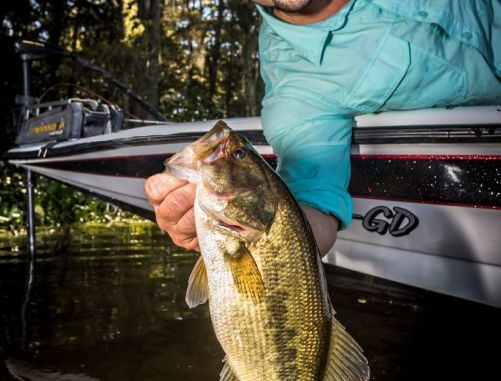
Shallow Lake Fausse Pointe offers great fall fishing
Lake Fausse Pointe flies under the radar, for the most part. Most people in South Louisiana know there’s a state park on the banks of the lake just north of Cherenton, but you don’t hear a lot of talk about its bass fishery.
That’s OK with most locals, like Abbeville’s Damein Clements, who know the drainage lake can provide some really good fishing — particularly in the spring and fall.
“You can about bank on 2- to 3-pounders, with a 4-pound kicker,” Clements said of the fishing this month. “You can look at a good 16-pound mark on a good day. A good average day will give you 14 pounds.”
The problem with Fausse Pointe — well, at least one of the issues, but more on another concern later — is that it fishes very small.
“For this time of year, it’s definitely about the cypress trees,” Clements said. “You just wiggle in and out of the trees.”
That means you’ll be fishing very shallow.
“The average depth (of the lake) is 5 feet,” Clements said. “The maximum depth is 6 feet. There are those man-made canals that reach 10 to 12 feet, but I don’t fish them because they get too much local pressure.”
But the bass don’t seem to mind that the water around the trees can be only a couple of feet deep.
“Those fish live shallow, so it doesn’t matter if you’re fishing 2 feet or 4 feet,” Clements said.
The key this month is shad, the tournament angler explained.
“You’re focusing on the baitfish that will be congregating,” Clements said. “Crawfish are over with, and now the shad are coming in and getting up on the points of trees.”
So, while the banks are literally lined with Spanish moss-draped cypress trees, Clement said it’s best to key on those trees forming points.
For the most part, he’ll be working two baits: a Cajun Tackle House Thumper Humper spinnerbait and a Missile Craw Father topped with a Cajun Tackle House Donkey Punch Skirt and a 5/16-ounce weight.
With the spinnerbait, Clements orders a variety of blades so he can mimic the bait he sees flickering.
“I match the hatch,” he said. “If I see some 5-inch shad flicker, I’m not going to throw a 31/2-inch blade.”
When he switches to flipping, the angler keeps the lure on the bottom and close to cover.
“I’m right in the bases of the roots or cypress knees,” Clements said. “They’ll be set up there, ready to pound on their prey.”
The most-productive days are those when clouds are non-existent.
“A bluebird day will set the fish up in the shadows and on the bases of those trees,” Clements explained. “That eliminates having to fish anywhere else.
“So you can focus on that and cover water.”
Now, back to one of the main problems with the lake — which is one of the reasons not many folks head that way.
It’s shallow. Very shallow.
As in, you’ve got a good chance of getting stuck on a sandbar or damaging your lower unit if you don’t know your way around.
“You don’t want to draw a straight line from Point A to Point B,” Clements said with a chuckle. “There are old duck blinds that are just left, and you have to know where they were last year.
“You could come across a 4×4 anywhere on the lake and knock your lower unit off.”
That’s especially important to remember if the wind has been blowing out of the north for any length of time.
“Any time you get a north wind on the lake, it’s going to drain that lake,” Clements said. “You get a north wind and a low tide — that’s when to move out.
“If I see the wind shifts to the north on tournament day, I might give it a try, but if it’s two days into a north wind, I don’t even try it.”
There’s a line of telephone poles along southeast end of the lake (against the Atchafalaya Basin levee) that marks the old channel, and Clements recommended running at least halfway down that stretch before turning into the main lake.
But even then, sinker logs, old duck blinds and sandbars can gobble your boat.
“After all these years — and I live minutes from the lake — I get stuck at least once a year,” Clements said.